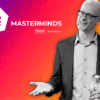

By David C Forman, bestselling author “Fearless Talent Choices”
WHY SHOULD YOU CARE?
The HR departments are often slandered for their lack of ability to provide business results. However, taking several of your organization’s most important initiatives and monetizing them is a good way to show that HR is there to drive business results and improve organizational performance.
The search for simple, powerful truths has always fascinated us. It would be wonderful and comforting to be able to reduce great complexity to one clarifying solution, action, or measure. Marcus Buckingham not only wrote a book on the subject, he created an acronym—TOTYNTK (the one thing you need to know). Everyone wants to know the secret—the one or two measures that will make everything better. The HR profession, often maligned for its lack of meaningful contributions, would desperately love an ultimate metric to boost its credibility.
But this search is unlikely to yield results because HR measures usually focus on internal practices or generic lists of external benchmarks. The problem with internal measures is they concentrate on efficiency, not effectiveness or results; and the issue with benchmarks is that they are backward views that others think are important. As has been said “You can’t benchmark your way to a breakthrough innovation such as the i Phone.” If you show a list of traditional HR metrics to business leaders, you are just as likely to elicit a yawn as any indication of support.
The reason for this tepid response is that HR often thinks of itself as an internal group focusing on protecting the organization, not a group that drives business results and builds organizational capability. When more of an external, business-centric perspective is embraced, there are indeed some measures that are more important than others.
These are four significant ways HR can improve organizational performance and drive business results. They are:
- Optimize Talent: Are your people aligned and doing the right things (not just doing things right). If a car is not aligned, it wanders all over the road. The same thing happens to an organization. Focus on engagement, retention, and collaboration, and improving the workplace so the workforce can flourish. Possible Actions: Have frequent check ins, use OKRs or OPAs to keep people aligned, employ practices that lead to a more engaged and committed workforce, encourage open talent marketplaces.
- Save Costs: Simplify processes, remove unnecessary barriers, identify waste, and explore new practices and technologies. Bureaucracies build up needless layers and get less efficient over time. Bust them up. Cost savings can hit the bottom line immediately, so their impact is quickly apparent. Possible Actions: Use hybrid work models, encourage smaller footprints, experiment with new technology platforms, reinforce flexible work arrangements, streamline organizational practices.
- Improve Productivity: Doing the same things better and faster and doing more with less. This happens by saving costs, simplifying current practices (see previous discussion), and expanding current output. These gains can be achieved by intelligent practices, informed automation, and smarter and more committed employees. Possible Actions: Promote open source bureaucracy busters, make productivity goals transparent, foster team competitions, empower self-governing teams.
- Expand Outcomes: Doing different things, using an expanded lens, and achieving new outcomes. This category is often associated with innovation, forging new connections and partners, and broadening the array of existing products, services and audiences. It can also arise by emphasizing unanticipated outcomes that are present but not previously considered important. Possible Actions: Sponsor open source innovation programs, involve customers more directly, consider anticipated and unanticipated consequences, use the lens of multiple bottom lines for different audiences.
These categories, of course, are inter-related. If a solution saves costs and is more efficient, it will likely contribute to greater productivity. Likewise, an engaged and collaborative workforce will be more productive and likely expand outcomes. Leaders throughout the organization will endorse these business-centric outcomes because they are the very results upon which they will be judged.
As Dave Ulrich has said:
“HR is not about HR, it is about the business.”
Conveying the Message
Once HR leaders endorse this “outside-in” approach, the next hurdle is how to convey the results. Traditional HR metrics are often expressed in non-business terms, such as number of hours of training, summary engagement scores, lost time, number of new patents, or turnover percentages. These may be useful as internal measures but are not compelling to others. Let me offer a few suggestions.
- Turnover. Usually, this discussion revolves around numbers of people who have left (avoidable and unnecessary turnover) or comparative industry benchmarks such as our turnover rate is 14% while the industry average is 18%. A more compelling case: Cisco know that it cost the organization $250,000 for every good engineer it loses. Last quarter we lost 8 quality engineers, and this cost the organization $2 million.
- Time to hire. This is an internal efficiency measure usually expressed in days. For example, the average time to hire for a certain position is 44 days, while the industry average is 49 days. A more compelling case: Turn the time a vacancy exists to lost productivity. If a sales position has a million dollar quota, every day that this position is unfilled costs the organization $4000.
- Innovation. The ability to innovate separates the winners from the losers in a highly competitive economy. At the simplest level, innovation can be measured by the number of patents granted or new product introduced in a given time period. But these, again, are not impact measures. A more compelling case: Focus on the amount of income generated by new products, not just the number of new products. The Vitality Index is a valuable metric that looks at the percentage of revenue generated by new products in, for example, a two year period. If that amount of revenue is less than 25% then the effectiveness of the organization’s creative abilities should be questioned.
- Customer retention. It is more expensive and time consuming to acquire new customers than retain the ones that you have. Customer retention is a critical measure for most B to C organizations, and a driver of profitability. Customer satisfaction surveys are often employed but can be misleading. A customer can be satisfied but still not renew. A better measure is customer loyalty and the percentage of customers that buy again and again. A more compelling case: Calculate the Lifetime Value of a Customer (CLV) and multiply it by the number of lost customers….the monetary impact can be staggering.
“Just because something can be counted, does mean that it counts.”
Albert Einstein
In each of these four situations, the more compelling case goes beyond a simple measure. The compelling case is a next level analysis that attempts to answer the question: So what does this mean to the business? And most often, the “so what” that counts is money. Money is not just the language of the business; it is the lubricant that allows it to operate. HR’s challenge then is to identify the business impacts of its practices and monetize them. When this happens, other business leaders listen more intently and take notice.
The Secret Formula
Benjamin Franklin was among the first to say that “time is money.” He was right then, and he is right now. One useful way to monetize business outcomes is to identify time savings and then turn these into financial impacts. For example, if a lean production process saves 4 days of time by eliminating unnecessary steps and barriers; it is not difficult to turn these time savings into money. The following table (based on two weeks of vacation, standard U.S. holidays with the costs of benefits included) can be used to convert time savings to money. The math is easy.
| Burdened Salary | Weekly | Daily | Hourly |
| $100K | $2083 | $416 | $52 |
| $125K | $2604 | $520 | $65 |
| $150K | $3125 | $624 | $78 |
| $200K | $4167 | $832 | $104 |
Figure 1: Weekly, Daily and Hourly Compensation by Salary Level
This table can also be used as a proxy measure for productivity gains (not just cost savings). It is easy for productivity to be measured for some roles. A salesperson is expected to meet or exceed a quota, as is a lawyer or consultant who has a billable rate target. But many of us are paid a salary to deliver value as part of a team or group, and this value is not so easily identified. In this case, a person’s salary is a good proxy measure for the value he or she contributes. Many would argue that salary is a very conservative measure and that a more realistic assessment would be two to four times salary (similar to a sales rep with a million dollar quota making 250K per year—a multiple of 4), but being conservative is a prudent choice for influencing other colleagues and business leaders.
Marcus Buckingham may have been right, after all. The TOTYNTK is that money is the ultimate HR metric. It is not perfect or precise; but it is meaningful to the business, credible to colleagues, and it reinforces the mindset that the purpose of HR is to drive business results and improve organizational performance. It counts. Take several of your organization’s most important initiatives and monetize them. Give it a try. It’s not as difficult as you think.
Written by: Dave Forman
Future of HR HR Strategy Strategy & Transformation
Previous post

- 68
labelPartner Content today2022.03.10.
Listen@Work – Increase employee engagement and enhance the employee experience through continuous employee listening
Underwriter: Effectory Watch the forum on demand. Recorded on 10th March, 2022. The HR Congress Forum presents:Listen@Work – Increase employee engagement and enhance the employee experience through continuous employee listening [...]
Similar posts

labelArticles today2024.10.21.
The success-recipe to build agile and future-ready organizations in 2025 and beyond








Post comments (0)